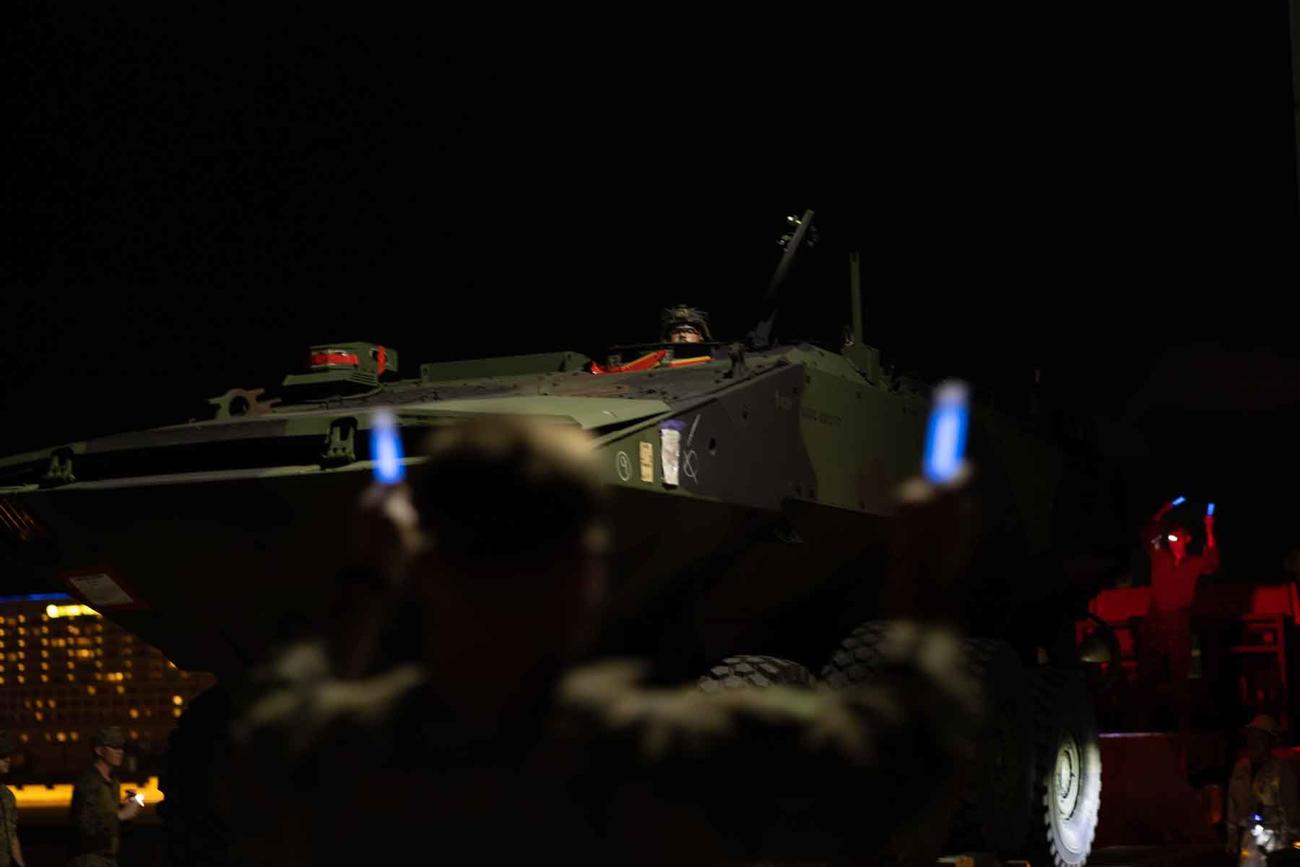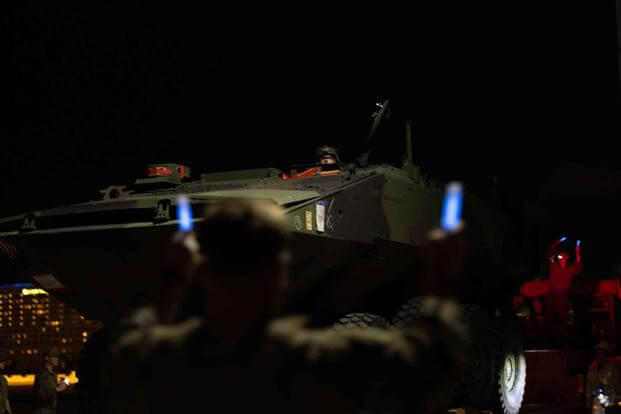

For two years, 1st Lt. Kenon Morgan trained his crew for the launch of the Marine Corps’ newest armored vehicle on its first overseas deployment.
Now aboard the USS Harpers Ferry, the 27-year-old platoon commander from Camp Pendleton is seeing the results of their preparation and called being part of the inaugural deployment for the Amphibious Combat Vehicle a “once-in-a-lifetime opportunity.”
This week, his platoon participated in the troop transport’s first ship-to-shore swim off Okinawa, Japan, where crews also practiced getting out of the vehicle in the water. The ACV can be used to carry infantry troops and their gear from ships waiting offshore to the beach, swimming up onto the sand and driving a couple hundred miles inland on one fueling.
“There are very few times when, as a service member, you get to be part of a new program for the Department of Defense,” Morgan said. “The ACV platoon gets to be the ones to do this for their first (deployment). We had a long training workup to get to this point.”
Sailing with two Navy ships in the Indo-Pacific Ocean, the 15th Marine Expeditionary Unit out of Camp Pendleton is the first to take ACVs aboard and use them in large international training events. It is also an opportunity for Marines to further test the new vehicles.
Already in development and testing, the vehicles were launched into service following the 2020 sinking of an Amphibious Assault Vehicle – a legacy transport the ACV is replacing – during a training exercise off San Clemente Island. Eight Marines and a sailor were killed, including three Marines from Southern California: Pfc. Bryan Baltierra, 18, of Corona; Lance Cpl. Marco A. Barranco, 21, of Montebello; and Cpl. Cesar A. Villanueva, 21, of Riverside.
While being put through their paces at Twentynine Palms and Camp Pendleton, the new ACVs encountered challenges in the surf zone, flipping four times as they were maneuvered through the waves. The ACV was kept off a 2022 deployment, and crews and troops were re-trained to operate and drive the vehicles.
Christopher Melkonian, deputy manager for the Marines’ Advanced Amphibious Assault Program, calls the ACV deployment a “monumental achievement” and credits collaboration between Marines and the vehicles’ manufacturer, BAE Systems, for addressing “readiness challenges” the vehicles experienced during testing at Camp Pendleton.
“The Marine Corps continues to gain insights from the ACV as we field it throughout the fleet, working with industry partners and Marines to rectify initial challenges with the platform,” he said. “We are excited to deploy the ACV in its intended environment, attached or embarked with a MEU.”
Marine commanders said they are relying on “the most experienced ACV crews in the Marine Corps” to provide feedback. Morgan said he is confident his platoon is up for the challenge, though some restrictions remain as the training progresses through the water conditions, such as the surf zone or open water, in which the machines will be used in real combat.
The ACV platoon and the ground troops that will be transported by the amphibious vehicles are two months into a likely seven-month deployment.
While in the Philippines last month, the ACV crews trained amidst a large exercise known as Balikatan – marking the Marines’ first overseas use of the ACVs.
Marines Corps leaders say the new vehicle – more than 200 are already in the fleet with three other variants on order – is the future of amphibious warfare, especially among the small islands of the Indo-Pacific, where tensions continue to rise.
In all, the service expects to have 632 ACVs when the orders with BAE are filled. The vehicles cost about $5.9 million each.
“ACVs offer flexibility, both over water and over land,” said Col. Sean Dynan, commanding officer of the 15th MEU. “It can take a punch and it can hit hard while moving Marines and sailors.”
Some Marines who are retired AAV officers have criticized the new vehicle’s rollout and worry its design is inherently flawed and prone to flipping in the surf zone, no matter how much retraining is being done. The 36-ton ACV rides on eight wheels, while the AVV, which has served the Marines for more than 50 years, rolls on tracks.
Following the deadly AAV tragedy in 2020, the Marines overhauled their amphibious training protocols and procedures with more attention to safety. The Marines have implemented new protocols requiring those riding in the amphibious transport pass intermediate swim tests and have addressed how and when troops get out of their vehicles.
When ACVs struggled in the surf zone off Camp Pendleton, exercises were paused and leaders took a second look at the training protocols for the vehicle, retooling the program.
Marine officials say the vehicle is up for the task ahead, and the platoon aboard the MEU will fine-tune challenges and become future mentors for other ACV crews.
Among the learning experiences is another historical first: Morgan’s platoon recently participated in a live-fire, waterborne gunnery range exercise in the Philippines. To get there, the ACVs launched from the well deck of the Harpers Ferry and swam and practiced coordinating shooting while afloat.
That left Morgan with “a huge sense of personal pride.”
“The capabilities of our platoon are far beyond the minimum of what is required to be successful,” he said.
“With ACVs aboard, commanders can launch a platoon carrying a rifle company from ship to shore, (which can) then travel deep inland in order to conduct operations,” Morgan said, explaining why the assault vehicles are critical to a MEU. When the ACVs come ashore, the armor protects against gunfire, artillery and mines.
“So its purpose is to allow the MEU to reach out and touch inland objectives from the sea, then return those Marines safely,” he said. “There’s also a lot of pride in knowing that the 15th MEU has confidence in us, our naval Amphibious Ready Group has confidence in us, and the Marine Corps and Congress have confidence in us to take these vehicles forward to employ them for the first time.”
Since the sinking of the AAV in training, protocols and procedures have been beefed up – all practiced on this current deployment, Morgan said. Vehicles are closely examined to ensure they are “mission capable” and are fully sealed. Troops boarding the vehicles must follow closely monitored checklists, including having life preserves and reviewing emergency procedures.
Adherence to standard operating procedures was found lacking by the investigation that followed the accident.
Then, once in the water and swimming ashore, “there is a whole scheme,” Morgan said, for vehicle commanders as they maneuver through the surf and onto shore.
“It’s a safety procedure,” he said. “It’s also heavy on communications between your vehicles, and there is a lot of responsibility for each of our vehicle commanders, and they are all well-trained for that.”
Marines have developed a driver training simulator to improve ACV operators’ performance and have also worked on technology to better read the surf zone, including a water drone that brings back information on ocean currents, the geography below the water and tides.
The driver simulator puts Marines into real-time scenarios and runs through at least 50 different situations. The system replicates the vehicle’s engine and dashboard performance displays and surf zones with multiple wave types, currents and random surf breaks. A simulator is aboard the USS Harpers Ferry, where ACV Marines can practice techniques while not in the vehicles.
As the deployment continues, Marine officials said they will continue to learn and perfect use of the vehicles, including getting them safely onto the ships, maintenance requirements, logistics, and how they integrate with other military forces.
Morgan, who didn’t know what an ACV was when he joined in 2021, said he now recognizes that it “sets the Marine Corps apart from other service branches.”
“A key part of those amphibious operations are vehicles like the ACV,” he said.
Morgan said he is thrilled with how his platoon is making a mark on Marine Corps history as part of those amphibious operations.
“Watching my Marines achieve as a combined force is an incredible honor, especially in a region and a time of great geopolitical significance,” he said. “They are exceedingly motivated to be laying the foundations for a new platform and to be an integral part of continuing the community’s legacy of amphibious operations.”
©2024 MediaNews Group, Inc. Visit ocregister.com. Distributed by Tribune Content Agency, LLC.
© Copyright 2024 The Orange County Register. All rights reserved. This material may not be published, broadcast, rewritten or redistributed.
